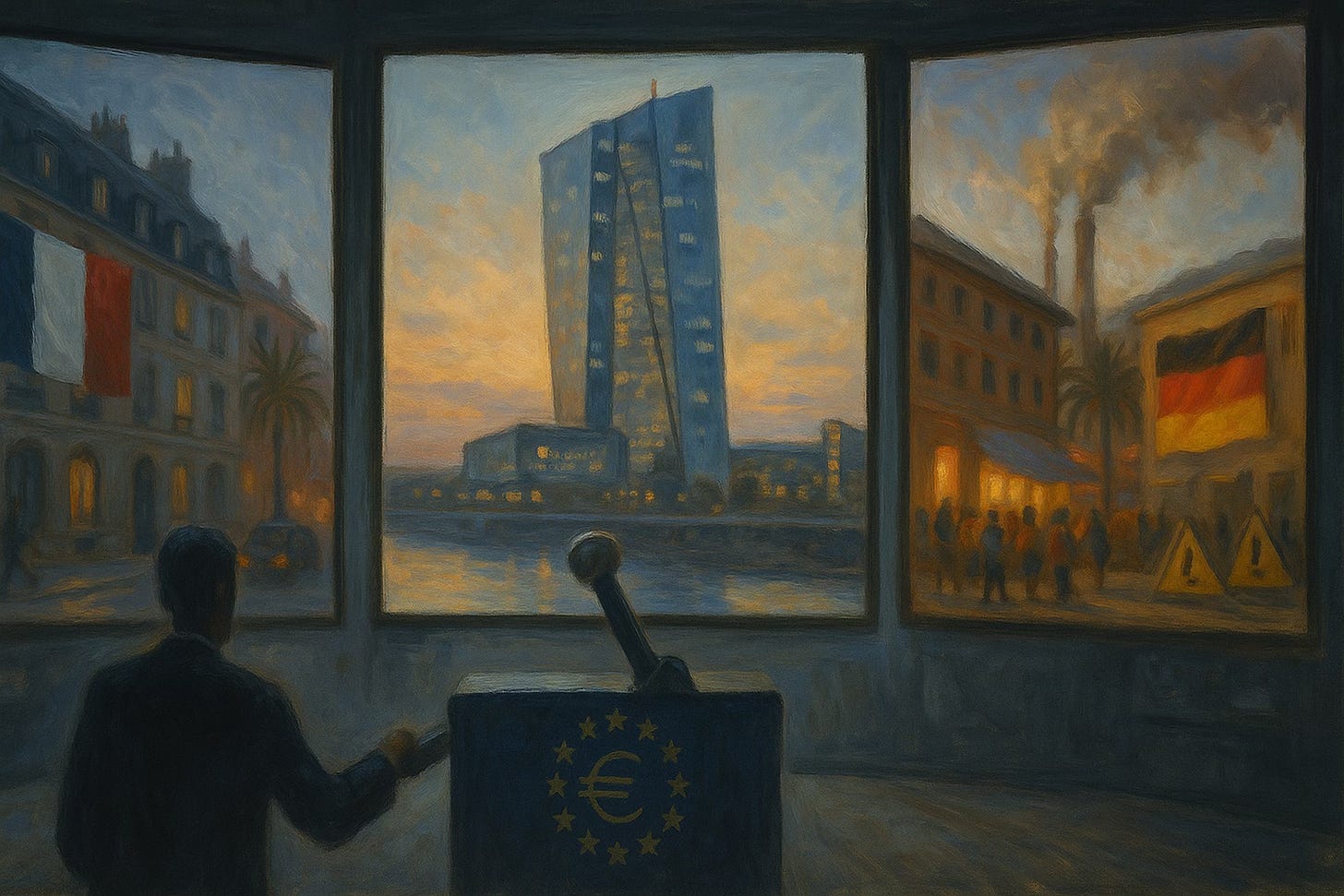France Cheats, Germany Waits, Spain Burns
One monetary policy, three different crises, and no plan to reconcile them.
The European Central Bank held interest rates steady on October 30th, keeping the deposit rate at 2.00%. The headline inflation figure sits at 2.1%, tantalizingly close to target. ECB President Christine Lagarde assured markets that policy settings are in a good place. Mission accomplished, right?
Except France’s inflation is running at 0.9%. Spain’s is at 3.2%. Germany clocks in at 2.3%.
The ECB just told Spain, where prices are rising more than three times faster than in France, that the exact same monetary policy works perfectly for both. It’s the fundamental flaw at the heart of the eurozone project.
Banque de France Governor François Villeroy de Galhau called the current stance a good position that is, naturally, not a fixed position. So nobody knows what comes next.
The headline number gives cover for this stance. Close enough to target that hawks can claim victory while doves can argue for patience. But averages are where the truth goes to die.
Core inflation, the measure that strips out volatile food and energy prices, sat stubbornly at 2.4%, exactly where it was the month before. More troubling, services inflation accelerated for the second straight month to 3.4%, its highest level since April.
Services inflation matters because it’s tied directly to wage growth and domestic demand, the stuff that doesn’t vanish when oil prices fluctuate. This is the embedded inflation the ECB supposedly tamed. It’s just hiding behind a headline number propped up by falling energy costs.
French inflation came in at 0.9% in October. While the eurozone average hovered above 2%, and Spain’s prices surged past 3%, France somehow achieved near-deflation. Villeroy de Galhau called it good news for the French economy. Fair enough, if anyone ignores how France got there.
Since 2022, the French government has deployed what it calls an energy tariff shield, bureaucrat-speak for artificially capping energy prices and spreading the cost across taxpayers. The cumulative fiscal cost ran about 2.2% of GDP over 2022-2023. The effect on reported inflation? A whopping negative 2.6 percentage points in 2022 alone.
France didn’t solve its inflation problem. It hid the problem behind government subsidies. As that shield gets unwound, the research projects it will add 2.2 percentage points back to French inflation, potentially in 2026.
So France’s current lowflation isn’t a triumph. It’s a fiscal time bomb on a delayed fuse. The ECB knows this. They’re just hoping nobody connects the dots.
Meanwhile, Germany’s core inflation sits at 2.8%, elevated and sticky. Spain’s prices are accelerating. The same 2.00% policy rate is simultaneously too restrictive for France and arguably too loose for Spain.
To be fair, there’s a coherent hawkish case here. That 3.4% services inflation number is real and rising. It reflects tight labor markets and wage pressures that won’t disappear because the ECB wishes them away. Cut rates prematurely, and the risk becomes reigniting the very price pressures that took three years to crush. So why rush?
Because the eurozone isn’t one economy. It’s twenty economies wearing a single monetary straitjacket.
When national inflation rates diverge by factors of three or more, the ECB’s mandate becomes incoherent. The data-dependent approach the ECB keeps touting isn’t flexibility. It’s paralysis dressed up as prudence.
Lithuanian council member Gediminas Šimkus previously argued for a December rate cut as insurance against unnecessary slowdown. He was overruled. But what exactly is the ECB’s credibility worth if its policy simultaneously overtightens some economies while undertightening others?
Watch the bond spreads to understand what markets actually think. The French 10-year OAT yield climbed above 3.4% in early November, even as French inflation printed at 0.9%. German Bunds sat at 2.64%. That’s a spread of roughly 77 basis points.
Investors are demanding significantly higher yields to hold French debt than German debt, despite France showing lower inflation and stronger growth than expected. This spread isn’t about monetary policy. It’s about fiscal risk.
France is trying to reduce its budget deficit from 5.4% to 4.7% of GDP amid political chaos. Markets don’t believe it will happen. So they’re pricing in dysfunction, enough that French debt carries meaningfully more risk than German.
This elevated spread acts as localized monetary tightening on France, even while the ECB holds its policy rate steady. French companies and consumers face higher borrowing costs than German ones, not because of inflation differences, but because of fiscal concerns. The supposedly unified monetary policy is fragmenting in real time.
Markets currently price the next ECB cut sometime in mid-2026, with only 45% probability of a move by September. But the structural divergence isn’t going away.
When France’s energy subsidies fully unwind, French inflation will jump. When Germany’s sticky core inflation finally moderates (if it does), German growth will likely slow further. Spain’s acceleration could peter out or accelerate. The ECB will have the same blunt instrument to address three completely different situations.
The research recommends staying underweight on French bonds despite low inflation, precisely because the fiscal risk premium won’t disappear. It suggests favoring cyclicals and financials that benefit from prolonged higher rates. These are the moves made when belief in the system has evaporated.
Maybe the eurozone needs different interest rates for different countries. Maybe a currency union without fiscal union was always a fantasy. Maybe watching France subsidize energy while Spain tightens belts while Germany deindustrializes, all under the same monetary policy, is exactly the outcome expected from a flawed design.
The ECB isn’t stupid. The economists in Frankfurt understand the divergence problem. But acknowledging it means admitting that the euro project has structural contradictions that monetary policy alone cannot solve.
So instead the world gets full optionality, agile pragmatism, and assurances that 2.1% average inflation proves everything’s fine.


